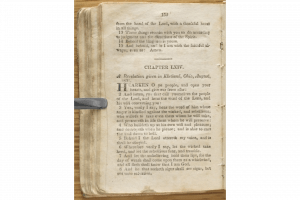Historical Context and Background of D&C 63
Brief Synopsis by Steven C. Harper
“The land of Zion,” says Joseph’s history, “was not the most important temporal object in view.” Satan hates Zion and works to undermine it from every angle. When Joseph and his companions returned to Kirtland, Ohio, from their trip to dedicate Independence, Missouri, as the center of Zion, they found “the exertions of Satan” had led many Saints into rebellion. Joseph and the faithful Saints were extraordinarily anxious about how to establish Zion.1
When and how should they gather to Missouri? How should they fund Zion and the move there? What should they do with their property in Ohio, like Whitney’s store and the farms belonging to Isaac Morley and Frederick Williams? The revelations in Missouri commanded the Saints to purchase land there. How should they raise the money? Sidney Rigdon had been commanded to write an inspired description of Zion and God’s will concerning it (D&C 58:50). What did the Lord think of his first draft? Isaac Morley had already moved to Missouri, and the several families living on his farm planned to follow as soon as the Lord said to go. Since Joseph and Sidney Rigdon and their families lived on Morley’s farm, selling it would leave them homeless. Where should they live?
Section 63 addresses the apostasy and these pressing questions related to literally building Zion. This revelation motivated much action. Joseph began discerning by the Spirit those who should move to Zion.2 As commanded, Titus Billings and several other Kirtland Saints moved to Missouri in the spring of 1832. Sidney Rigdon humbled himself and rewrote a description of the land of Zion based very much on this revelation and previous ones.3
Oliver Cowdery and Newel Whitney used it to obey the command to go
from place to place, and from Church to Church preaching and expounding the Scriptures and Commandments [that is, the recent revelations] and obtaining moneys of the disciples for the purpose of buying lands for the Saints according to commandments and the disciples truly opened their hearts.
Oliver Cowdery and John Whitmer took the money to bishop Partridge and Sidney Gilbert in Missouri, “and thus there has been lands purchased, for the inheritance of the Saints.”4
As commanded, Newel Whitney and Frederick Williams kept their property in Kirtland and consecrated it to the Church. As for Joseph, Sidney Rigdon, and their families, they moved south to Hiram, Ohio, in September 1831 where Elsa and John Johnson provided homes for them. Yes, there was apostasy—adultery, lying, hypocrisy, rebellion—in Kirtland when the Lord gave section 63. There was also substantial Zion-building in response to it.
1. “History, 1838–1856, volume A-1 [23 December 1805–30 August 1834],” p. 146, The Joseph Smith Papers, accessed September 5, 2020.
2. D&C 63:41. The Church History Library has an unpublished revelation in John Whitmer’s handwriting, dated August 31, 1831, which says: “Behold thus saith the Lord by the voice of the spirit it is wisdom in me that my servent John Burk David Eliot Erastus Babit should take their Journey this fall to the land of Zion.”
3. Sidney Rigdon Papers, Church History Library. Published in Cook, Revelations of the Prophet Joseph Smith, 99–101.
4. “John Whitmer, History, 1831–circa 1847,” p. 37, The Joseph Smith Papers, accessed September 5, 2020.
Additional Context, by Casey Paul Griffiths
From Doctrine and Covenants Minute
From June 19 to August 27, 1831, Joseph Smith was away from Kirtland, Ohio, as he traveled to and from Independence, Missouri, to identify the location of the city of Zion (D&C 57–62). Returning from his trip to Zion, Joseph faced several decisions. He later noted in his history, “Many things transpired upon this journey to strengthen our faith, and which displayed the goodness of God in such a marvelous manner.” He also noted “that we could not help beholding the exertions of Satan to blind the eyes of the people so as to hide the true light that lights every man that comes into the world” (JS History, vol. A-1, 146, JSP). While the difficult expedition strengthened the faith of many, some of the elders who went on the trip complained and moved quickly toward apostasy. Meanwhile, some of the members in Kirtland had also fallen away. John Whitmer noted, “The Elders had returned to their homes in Ohio, the churches needed much exhortation[;] in the absence of the Elders many apostatized” (John Whitmer History, 33, JSP).
Another pressing issue arose now that the location of the city of Zion had been identified. Many Church members desired to leave for Zion right away, and Joseph and the other Church leaders faced the dilemma of finding the best way to organize the migration to Missouri. Joseph later recorded, “In these infant days of the church, there was a great anxiety to obtain the word of the Lord upon every subject that in any way concerned our salvation; and as ‘the land of Zion’ was now the most important temporal object in view, I inquired of the Lord for further information upon the gathering of the Saints and the purchase of the land and other matters, and received the following [D&C 63]” (JS History, vol. A-1, 146, JSP).
See “Historical Introduction,” Revelation, 30 August 1831 [D&C 63]

